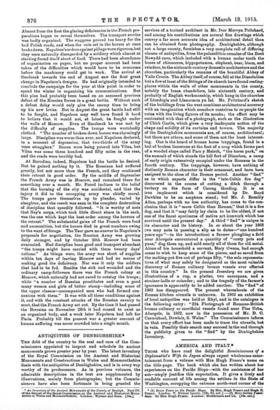ANTIQUITIES OF DENBIGHSHIRE.* THE debt of the country to the
zeal and care of the Com- tuissioners appointed to inspect and schedule its ancient monuments grows greater year by year. The latest inventory of the Royal Commission on the Ancient and Historical Monuments and Constructions in Wales and Monmouthshire deals with the antiquities of Denbighshire, and is in every way worthy of its predecessors. As in previous volumes, the admirable descriptions in the text are supplemented by illustrations, mainly from photographs ; but the Commis- sioners have also been fortunate in being granted the
- • Al1 1110011t1011 of the Ancient Ymninenta a/ the Counts of Denbigh. Part IV. s4-OssEeru.....nnEoSALEenimiasIon 011 the Ancient and Historical Mon. manta in Wales mid Moureouilsolvira London: Wyman and Son. E10.1.
services of a trained architect in Mr. Ivor Mervyn Pritohard, and among his contributions are several fine drawings which convey a far more accurate idea of architectural detail than can be obtained from photography. Denbighshire, although not a large county, furnishes a very complete roll of differing classes of antiquities, from the palaeolithic remains of the Bunt Newydd cave, which included with a human molar tooth the bones of rhinoceros, hippopotamus, elephant, bear, bison, and reindeer, to the sixteenth-century domestic architecture and the churches, particularly the remains of the beautiful Abbey of Valle Crude. The Abbey itaelf,of course, fell at the Dissolution huts few at least of the fittings of its church have found resting- placea within the walls of other monuments in the county. notably the brass chandeliers, late sixteenth century, and probably of English workmanship, which hang in the churches of Llandegla and Llanarmon yn Ial. Mr. Pritchard's sketch of the buildings from the west combines architectural accuracy with an imagination which somehow contrives to re-people the ruins with the living figures of its monks ; the effect may be contrasted with that of a photograph, snob as the illustration of Chirk Castle, which gives a very inadequate notion of the shape and solidity of its curtains and towers. The majority of the Denbighshire monuments are, of course, architectural; but there are others, and some of them not the least interest- ing. One is the hoard of bronze horse trappings, found in a bed of broken limestone at the foot of a crag which forms part of a wooded slope called Parc y Meirch, "the horse park," on the summit of which stands the hill fort of Dinorben, a camp of early origin extensively occupied under the Romans in the fourth century. The trappings, however, have nothing of distinctly Roman character in their ornament, and have been assigned to the close of the Bronze period. Another "find" as to which experts differ is the "late-Celtic fire dog" discovered in the course of cutting a ditch through a turbary on the farm of Carreg Goediog. It is an iron implement which ii considered by Dr. Boyd Dawkins to be an amphora stand ; but Mr. J. Romilly Allen, perhaps with no less authority, has come to the con- clusion that it is "more Celtic than Roman," that it is a fire dog, and that it" may fairly lay claim to be the oldest, if not one of the finest specimens of native art ironwork which has survived until the present day." A third "find" is unique in its character and its history. In or about the year 1862 (we may note in passing a slip as to dates--" one hundred years ago "—in the introduction) a farmer ploughing a field near Abergele encountered a quantity of "rusty pots and pane," dug them up, and sold nearly all of them for old metal. Alone of his houeehold a servant, Mary Owens, had enongit sense to wish to keep some of the pieces, and so saved from the melting-pot five out of perhaps fifty, "the sole representa- tives of what may safely be designated as the most valuable discovery of Roman culinary bronze vessels ever effected in this country." In the present Inventory we are given illustrations of a cup, a platter, two saucepans, and a strainer-ladle or colander, and to the tragedy of the farmer's ignorance is apparently to be added another. The "find" of 1862 has disappeared. The present whereabouts of the Roman kitchen utensils is unknown. In 1902 an exhibition of local antiquities was held at Rhyl, and in the catalogue is the following entry : "224. Photograph of Romano-British bronze culinary or sacrificial vessels found near Plas riche. Abergele, in 1862, now in the posaession of Dlr. D. C. Carmiohael, Dowlais, S. Wales." The Commissioners inform us that every effort has been made to trace the utensils. but in vain. Possibly their search may succeed in the end through the publicity given to the " find " by the Denbighshire Inventory.


































 Previous page
Previous page